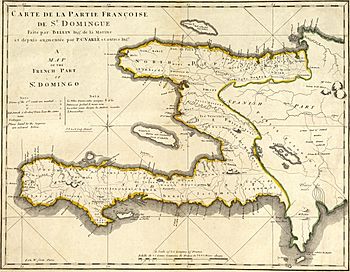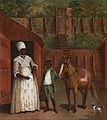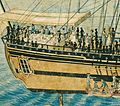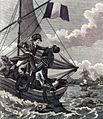Saint-Domingue facts for kids
Quick facts for kids
Saint-Domingue
|
|||||||||
|---|---|---|---|---|---|---|---|---|---|
| 1625–1804 | |||||||||
 |
|||||||||
| Status | Colony of France | ||||||||
| Capital | Cap-Français (1711–1770) Port-au-Prince (1770–1804) |
||||||||
| Common languages | French, Haitian Creole | ||||||||
| Religion | Roman Catholicism | ||||||||
| Government | Absolute monarchy (until 1792) Republic (1792–1804) |
||||||||
| King | |||||||||
|
• 1625–1643
|
Louis XIII | ||||||||
|
• 1643–1715
|
Louis XIV | ||||||||
|
• 1715–1774
|
Louis XV | ||||||||
| Head of State of the French Republic | |||||||||
|
• 1792–1795
|
National Convention | ||||||||
|
• 1795–1799
|
French Directory | ||||||||
|
• 1799–1804
|
Napoléon Bonaparte | ||||||||
| History | |||||||||
|
• First French settlement
|
1625 | ||||||||
| 1697 | |||||||||
| January 1 1804 | |||||||||
| Area | |||||||||
| 21,550 km2 (8,320 sq mi) | |||||||||
| Currency | Saint-Domingue livre | ||||||||
|
|||||||||
| Today part of | |||||||||
Saint-Domingue was a French colony in the Caribbean. It was located on the island of Hispaniola from 1659 to 1804. Today, this area is known as Haiti.
French settlers first arrived on the western part of Hispaniola and the nearby island of Tortuga by 1659. In 1697, a peace agreement called the Treaty of Ryswick was signed. Through this treaty, Spain officially agreed that France controlled Tortuga Island and the western third of Hispaniola.
In 1791, enslaved people and some free people of color in Saint-Domingue started a major uprising. This was a rebellion against French rule. The rebels agreed to French rule again after slavery was ended in the colony in 1793. However, this upset the powerful slave-owning class on the island. France controlled all of Hispaniola from 1795 to 1802. Then, a new rebellion began. The last French soldiers left the western part of the island in late 1803. The colony then declared its independence as Haiti the next year. Haiti was the original name for the land.
Contents
What Was Saint-Domingue?
Spain had control over the entire island of Hispaniola from the 1490s. This lasted until the 1600s. At that time, French pirates began setting up bases on the western side of the island. The Spanish called the island La Española, meaning "The Spanish Island." It was also known as Santo Domingo. This name came from Saint Dominic.
The Spanish government did not pay much attention to the western part of Hispaniola. Because of this, French buccaneers started to settle there. They first settled on Tortuga Island. Then, they moved to the northwest of Hispaniola. They called this area le Grande Terre (the Great Land). Later, Spain gave the entire western coast of the island to France. Spain kept the rest of the island, including the Guava Valley. Today, this area is known as the Central Plateau.
The French named their part of Hispaniola Saint-Domingue. This was the French version of Santo Domingo. The Spanish colony on Hispaniola stayed separate. It eventually became the Dominican Republic. Its capital city is still named Santo Domingo.
The Haitian Revolution: Fight for Freedom
The Haitian Revolution was a very important event. It was a successful uprising by enslaved people. They fought for their freedom from French rule.
Causes of the Revolution
Life for enslaved people in Saint-Domingue was extremely harsh. They worked on sugar and coffee plantations. These plantations made a lot of money for France. However, the enslaved people had no rights. They were treated very cruelly. This unfair system led to deep anger and a desire for freedom.
The ideas of the French Revolution (1789-1799) also played a role. These ideas were about liberty, equality, and brotherhood. They inspired many people in Saint-Domingue. Both enslaved people and free people of color wanted these rights for themselves.
Key Events and Leaders
The rebellion began in August 1791. Enslaved people rose up against their owners. They burned plantations and fought for their freedom.
One of the most famous leaders was Toussaint L'Ouverture. He was a brilliant military leader and strategist. He helped turn the scattered rebellions into a powerful army. He fought against the French, Spanish, and British forces.
In 1793, France officially ended slavery in Saint-Domingue. This was a big victory for the rebels. However, Napoleon Bonaparte later tried to bring slavery back. This led to more fighting.
Independence and Legacy
The fight for independence continued. In 1803, the French forces were defeated. On January 1, 1804, Saint-Domingue declared its independence. It became the new nation of Haiti. This was a historic moment. Haiti was the first free black republic in the world. It was also the only nation created from a successful slave revolt.
The Haitian Revolution showed that enslaved people could fight for and win their freedom. It inspired other enslaved people in the Americas. It also had a big impact on the world. It showed that the ideas of liberty and equality could apply to everyone.
Images for kids
-
Drawing of a slave sale aboard the Marie Séraphique in the waters off Cap‑Français, 1773
-
Jean-Baptiste Belley, an affranchi (a freed person of color) who became a rich planter. He was elected to the Estates General for Saint-Domingue, and later became a Deputy of the French National Convention.
-
Enslaved people having a stick fight. A white engagé (indentured servant) is on the left.
-
Toussaint L'Ouverture with Sonthonax
-
Republican abolitionist and Jacobin Léger-Félicité Sonthonax
See also
 In Spanish: Saint-Domingue para niños
In Spanish: Saint-Domingue para niños
























